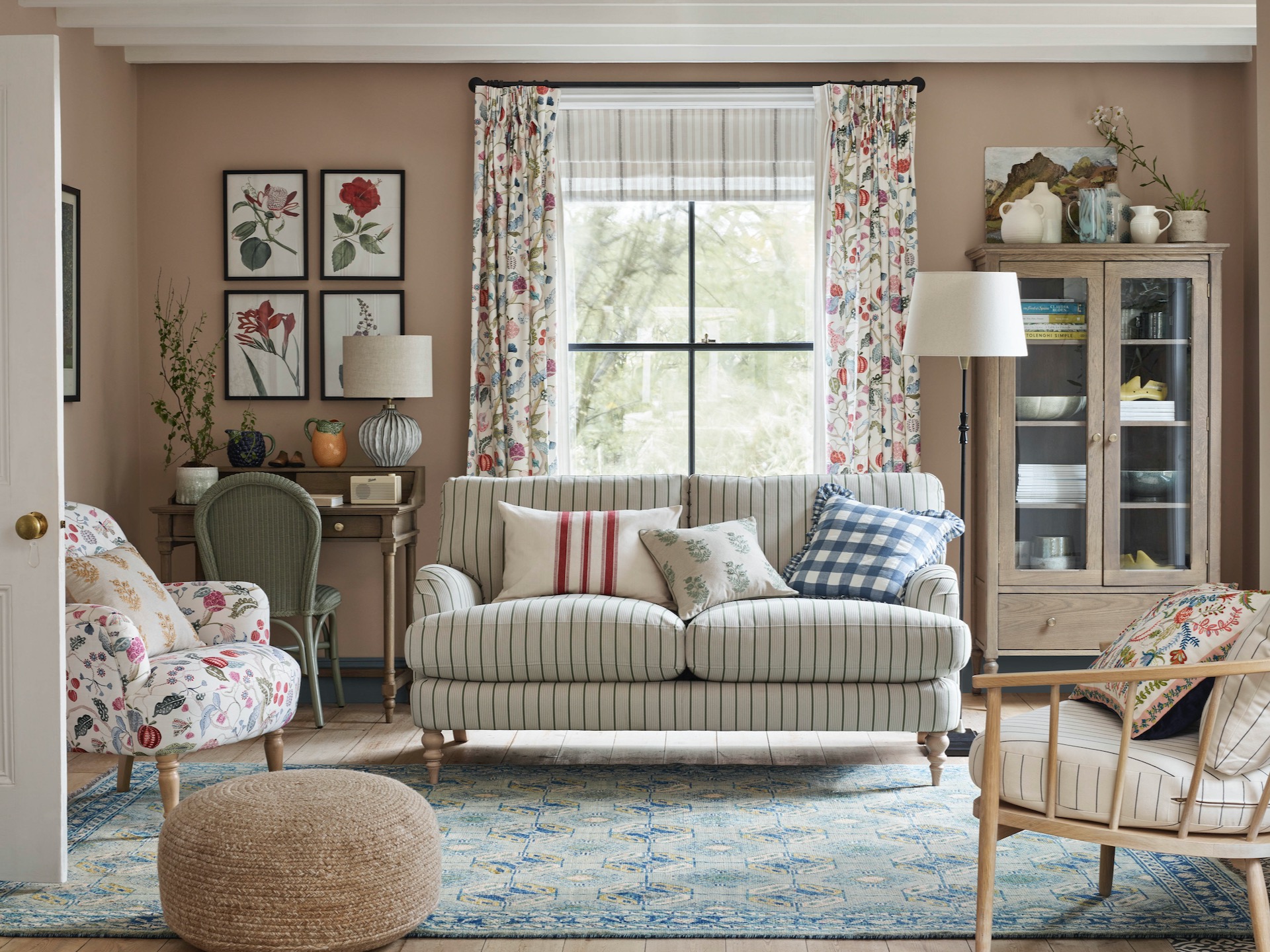
Image credit: John Lewis
Try these easy living room updates to create a new room for less
Aside from your kitchen, the living room is probably the busiest room in your home. So it’s understandable that it can quickly look tired – and that’s where our easy living room updates come in.
Unless you have unlimited funds, it’s unlikely you’ll be able to (or want to) completely redecorate your living room every year or two. But if you’re desperate to ring the changes somehow, there’s a lot you can do to make a difference on a budget.
Our tricks and tips can be worked into any style of home. And most, if not all, are rental-friendly decor ideas. Only two – cladding the walls and repainting – will ultimately rely on your landlord agreeing that a little light decorating is beneficial to both of you. But do ask permission first in those cases.
1. Cover a tired floor
Whether you’ve bought or are renting, a scratched-up wood floor or stained carpet can be the bane of a living room. Replacing it may not be an option for multiple reasons – and not worth it if, say, you’ve got pets or small children. But an area rug can provide an instant transformation. Best of all, it can be rolled up and put back down as and when the occasion requires it.
“Adding a new rug can instantly transform a living room and is one of the easiest ways to create a luxurious touch without making a large investment,” says Punam Chada, carpet buyer at Carpetright.
“If you’re looking for an area rug to refresh a space but not sure where to start, here’s a good
checklist to follow: purpose; material content; dimensions; colour and pattern; aftercare;
price.
“Apart from its extra ‘snuggle-factor’, what else is the purpose of your rug? Do you want it to
sit like an art piece and make a statement? Is it needed to create zones within an open-plan
space, used to unify or break up parts of the room? Or might it be needed for an injection of
colour as well as added comfort?”
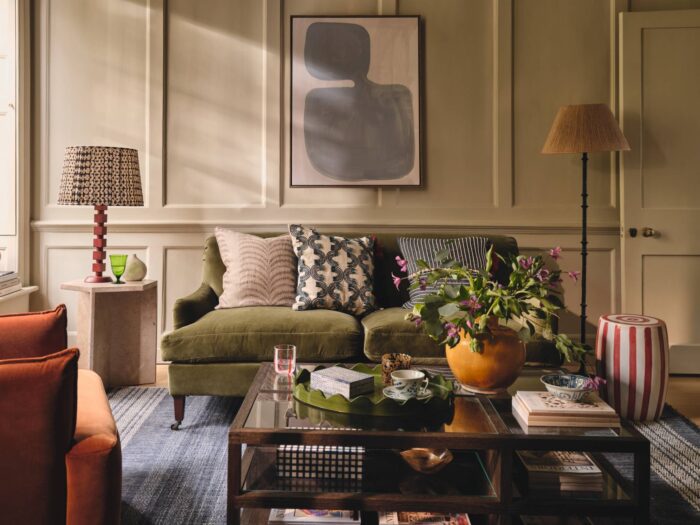
When it comes to composition, area rugs made from wool are the best for keeping warm
and creating spaces perfect for getting comfortable on, but they can be pricey. Cotton or polyester rugs are usually less expensive, can look just as good and are easier to clean.
Punam adds, “Determining the size of rug is a great starting point and will depend on not only the
dimensions of your room but also what you’re looking to place upon it. Look at how many
pieces you’re hoping to place on top of the rug and work from there.
“The fun part is picking out the colour and pattern for your new rug but always consider the
likely traffic through the space. Earth coloured sisal or bold patterned rugs will perform
better beneath a busy dining table than a light-coloured soft rug.”
2. (Ad)dress your sofa
A stain here, a scuff there – your beautiful sofa may still be comfy but not necessarily that presentable. That’s where a cushion-and-throw-based makeover is in order. Start with cushions – they’re one of the most underrated yet most impactful buys to change up your upholstery in an instant.
Mix up your sizes – but make sure you include larger cushions of 40cm or more – and go for feather-filled pads for luxury. It’s important to play with texture, too. Mongolian lambswool is a particular favourite of this writer, but there’s so much to choose from. Boucle or fur and velvet work well, as do cotton, knits or sheepskin.
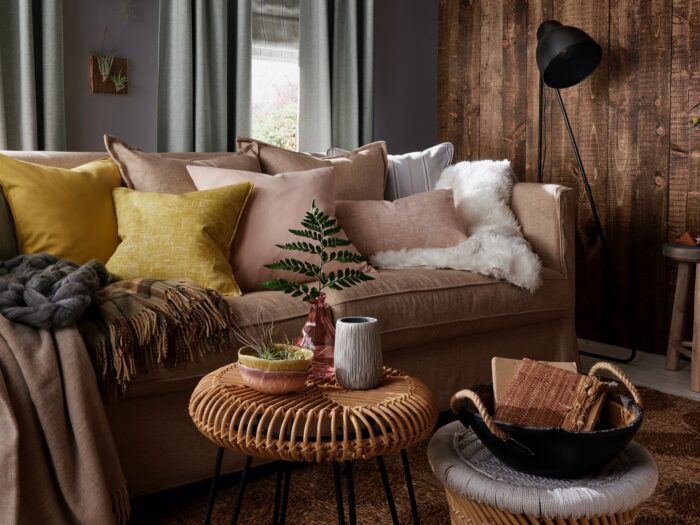
Throws can go a long way too, and not just as a cover-up. Try draping one over the back or arm of a sofa or armchair – the added layer will bring style, texture and a ‘come cosy up’ vibe to your furniture. Natural fibres and neutral shades are a stylist go-to, so a good jump-off point for beginners, while a check will give you a strong heritage look. Pastel blue- or green-and-white stripes will feel classically French – read country chic.
3. Create a gallery wall
Let’s be honest, the focal point of most living rooms will be the TV. But why not change things up with a gallery wall. The trick to success is to have some consistency. Usually this will be the frame colour and/or the colour palette of the artwork itself.
In the arrangement below, the frame colour is always black, albeit in different sizes, and the prints have similar cream and green tones.
You could also choose to have a wall of black-and-white family photos, or a mix of slogans and graphic prints. But try to stick to a theme – frames and prints in a mix of colours and designs can look messy.
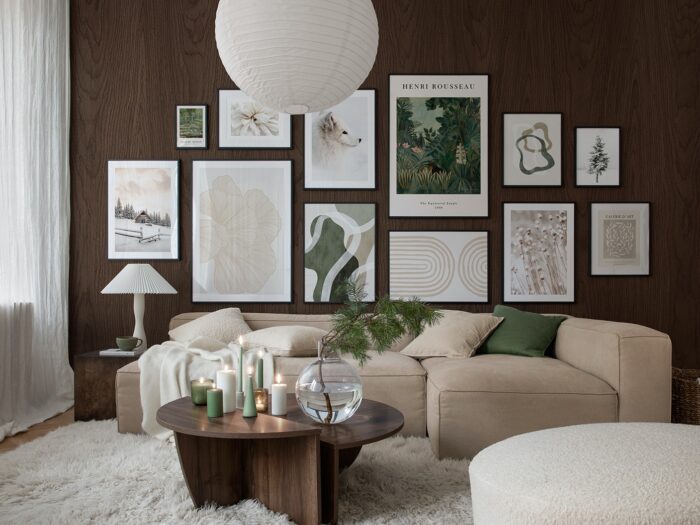
If you’re living in a rental, or would like to play around with the position of your pictures over time, you don’t need a drill.
“Using Command hooks and Command strips is my preferred way to avoid wall damage,” advises Nick Ee, product training manager at Black + Decker. “They will work when applied to metal, tile, glass, painted drywall, and painted or varnished wood but not wallpapered surfaces.”
4. Reupholster your chairs
Our next easy living room update is one of our most satisfying. Anyone that’s ever watched an episode of BBC’s Money For Nothing knows the joy that can be had from taking a tired chair or sofa and reupholstering it. It’s not only the fabric that can make the transformation – it’s also the new padding, structural restoration and piping. And the satisfaction that you’re saving something from landfill.
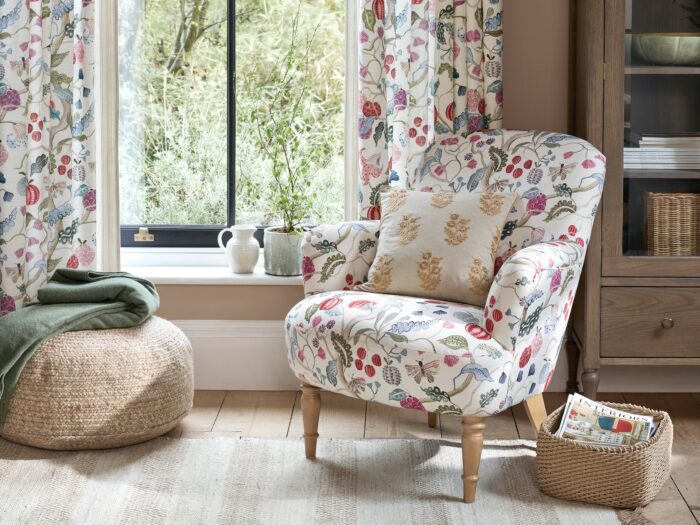
According to pre-owned furniture marketplace Vinterior, having a piece of furniture upholstered can cost anywhere from £75 to £500, depending on the size and condition of the piece. Or you could think about learning a skill that you can use to do it yourself, forever more.
A 10-week upholstery course at West Herts College (three hours per week) costs £145, where you’ll learn the essentials, such as measuring and estimating material, stripping frames and replacing the required materials.
5. Go wild for plants
If there’s one room in the home well suited to a big show of houseplants, it’s the living room. That’s according to RHS Chelsea Flower Show gold medal-winner Ian Drummond and interiors writer Kara O’Reilly, authors of At Home With Plants, £18.40, Amazon.
“The living room is usually the biggest room in the house, which is why it lends itself to such large-scale displays,” they tell us. “A large-scale display is one that is either tall or bold, or involves a grouping of several different plants and containers.”
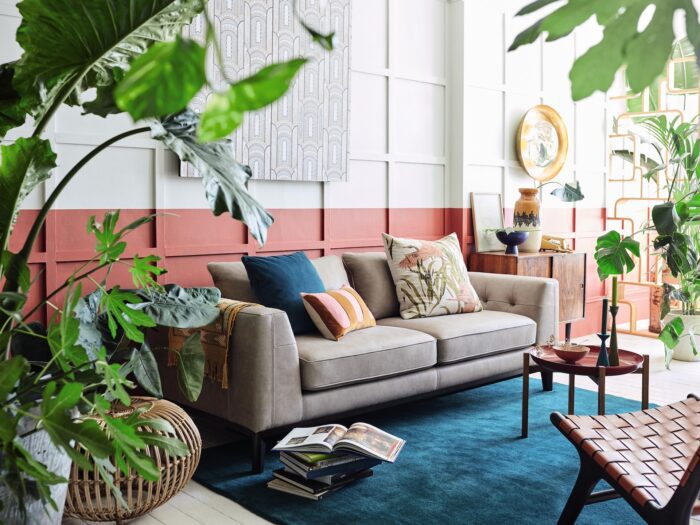
They add, “This type of planting design can serve several purposes: to create a focal point in a room that previously didn’t have one; to separate and screen off different areas within the room; to disguise unsightly views; or simply to act as a beautiful piece of living sculpture.”
Plants suitable for such a look include the Kentia palm, rubber plant, Chinese windmill palm, weeping fig, finger tree and Madagascar dragon tree.
6. Play with paint
You don’t need a lot of paint to make a difference in a living room. A small 750ml tin or even a few tester pots is enough to create a stir. Take these clever little accents from Benjamin Moore. To the left, a flash of orange highlights a corner of the room. You could use this to draw attention to a favourite piece of furniture, or to highlight an area of the room that serves a separate purpose, such as reading or study.
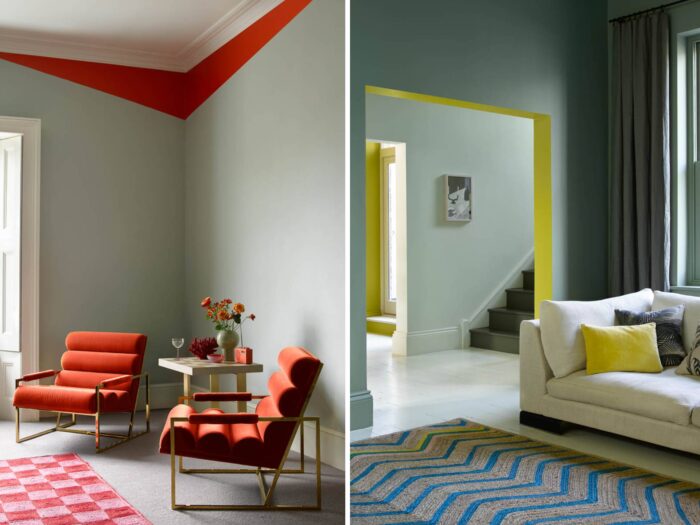
To the right, an opening is given a flash of yellow that creates a thread to the room beyond, painted in the same shade. Both looks work to take what is a muted living room scheme and – in conjunction with coordinating new additions such as a bright armchair, a geometric rug or even new cushions – take it in a maximalist direction. Without breaking the bank.
7. Experiment with lighting
If you’re totally reliant on your living room’s ‘big light’, as Peter Kay would put it, you could be missing a trick. Having a spacecraft of a light fitting hovering overhead is hardly conducive to relaxation, so instead, embrace mood lighting through table and floor lamps, with warm 40W bulbs and pretty lampshades for a soft, layered look. You’ll be surprised at the difference it makes after dark.
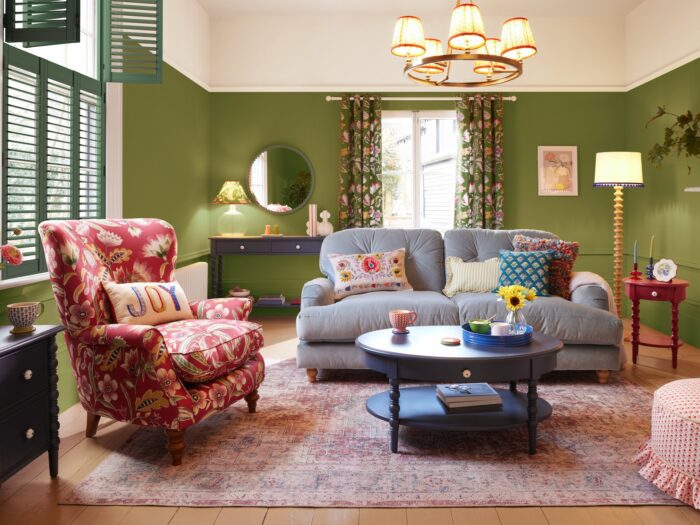
“Layering your living room lighting is an essential part of updating a design, as it brings flexibility into a space,” says Julian Page, head of design at BHS. “Consider adding in floor lamps that have a sculptural aesthetic. These accent lights highlight reading nooks and dark corners, whilst acting as a piece of art when turned off.
“Soft mood lighting is key in your living room as it helps to wind down and relax after a long day. You can achieve this with table lights. Consider placing table lamps on either side of the sofa to create symmetry or place them next to pieces of artwork to highlight features around the room.”
8. Clad the walls
Wall panelling can make a huge different to a living room. In this space styled by Marks & Spencer, vertical slats bring warmth and an on-trend edge, and will make a space with low ceilings appear taller.
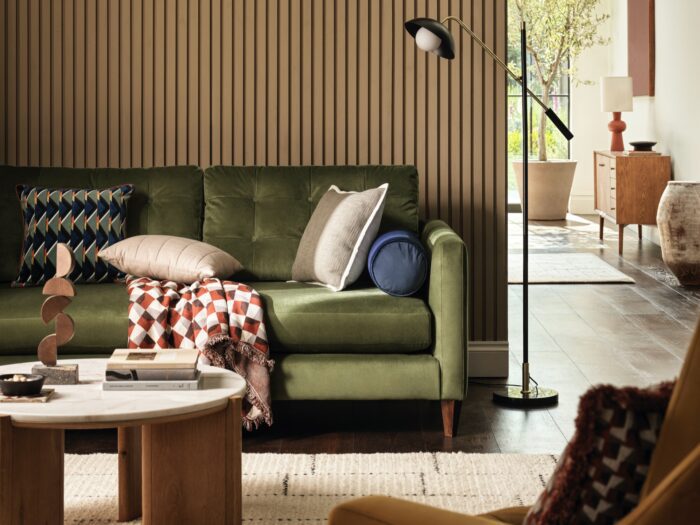
Panelling’s benefits aren’t just aesthetic, either. Acupanel’s contemporary oak acoustic wood wall panels (a favourite of rapper Tinie Tempah, no less) have a similar look and excellent sound absorption properties. So if you’re looking to create a relaxing snug off a busy family space, they’re ideal.
They are easy to install, either by screwing them directly into the wall with the correct fixings, or for extra soundproofing, by attaching them to batons fixed to the wall.
9. Rearrange your furniture
It may sound unlikely, but moving your sofa and storage around could have a transformative effect on your living room.
“Don’t feel that your sofa needs to sit against the wall,” says Dominic Harrison, designer at at King Living. “Pulling it off the wall will create the illusion of space and make the room feel better.”
It will also improve airflow and make your walls less prone to damp – particularly external ones.
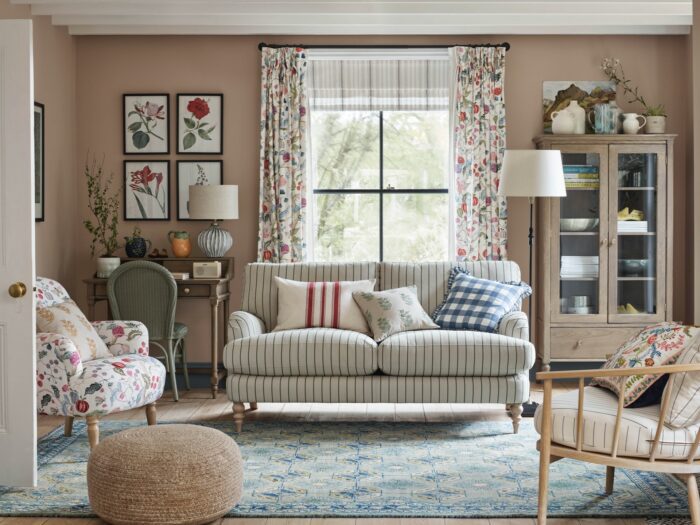
Start by assessing your furniture – make sure nothing is too big or too small for the room. Then position the largest pieces first, making sure not to block the flow of traffic if your room has more than one doorway. If you practise the art of Feng Shui, your most important piece of funiture – likely the sofa – should sit in the commanding position. This is the spot furthest away from the door, on a diagonal from it.
Another trick is to zone your space – particularly if it’s used for more than lazing in front of the TV. In the room above, a study-cum-work area has been created in a corner by the window, so whoever uses it benefits from the extra productivity that natural light brings.




